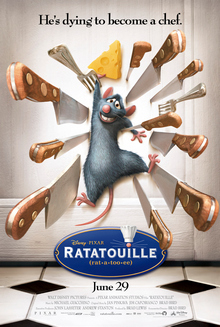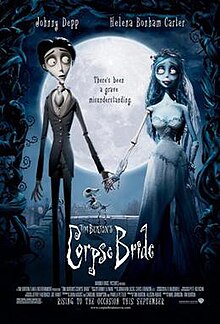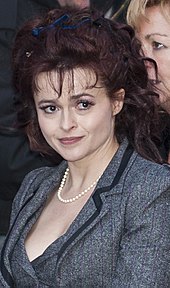
Animation is a filmmaking technique by which still images are manipulated to create moving images. In traditional animation, images are drawn or painted by hand on transparent celluloid sheets (cels) to be photographed and exhibited on film. Animation has been recognized as an artistic medium, specifically within the entertainment industry. Many animations are computer animations made with computer-generated imagery (CGI). Stop motion animation, in particular claymation, has continued to exist alongside these other forms.

Stop motion is an animated filmmaking technique in which objects are physically manipulated in small increments between individually photographed frames so that they will appear to exhibit independent motion or change when the series of frames is played back. Any kind of object can thus be animated, but puppets with movable joints or plasticine figures are most commonly used. Puppets, models or clay figures built around an armature are used in model animation. Stop motion with live actors is often referred to as pixilation. Stop motion of flat materials such as paper, fabrics or photographs is usually called cutout animation.

Timothy Walter Burton is an American director, producer, writer, and animator. Known for pioneering goth culture in the American film industry, Burton is famous for his gothic horror and fantasy films. He has received numerous accolades including an Emmy Award, and a Golden Globe Award as well as nominations for two Academy Awards and three BAFTA Awards. He was honored with the Venice International Film Festival's Golden Lion for Lifetime Achievement in 2007 and was given the Order of the Arts and Letters by Culture Minister of France in 2010.

Frankenweenie is a 1984 American science fiction comedy horror featurette directed by Tim Burton and written by him and Leonard Ripps. It is both a parody and homage to the 1931 film Frankenstein based on Mary Shelley's 1818 novel Frankenstein; or, The Modern Prometheus. Burton later directed a feature-length stop-motion animated remake, released in 2012.

Cars is a 2006 American animated sports comedy film produced by Pixar Animation Studios for Walt Disney Pictures. The film was directed by John Lasseter, co-directed by Joe Ranft, produced by Darla K. Anderson, and written by Dan Fogelman, Lasseter, Ranft, Kiel Murray, Phil Lorin, and Jorgen Klubien, and was the final film independently produced by Pixar after its purchase by Disney in January 2006. The film features an ensemble voice cast of Owen Wilson, Paul Newman, Bonnie Hunt, Larry the Cable Guy, Tony Shalhoub, Cheech Marin, Michael Wallis, George Carlin, Paul Dooley, Jenifer Lewis, Guido Quaroni, Michael Keaton, Katherine Helmond, John Ratzenberger and Richard Petty, while race car drivers Dale Earnhardt Jr., Mario Andretti, Michael Schumacher and car enthusiast Jay Leno voice themselves.

Vincent is a 1982 American stop-motion animated short film written, designed and directed by Tim Burton, and produced by Rick Heinrichs. There is currently no individual release of the film except for a few bootleg releases. It can be found on the 2008 Special Edition and Collector's Edition DVDs of The Nightmare Before Christmas as a bonus feature and on the Cinema16 DVD American Short Films.

Flushed Away is a 2006 animated adventure comedy film directed by Sam Fell and David Bowers, produced by Cecil Kramer, David Sproxton, and Peter Lord, and written by Dick Clement, Ian La Frenais, Chris Lloyd, Joe Keenan and Will Davies. It was the third and final DreamWorks Animation film co-produced with Aardman Features following Chicken Run (2000) and Wallace & Gromit: The Curse of the Were-Rabbit (2005), and was the first Aardman project mostly made in CGI animation as opposed to starting with their usual stop-motion – this was because using water on plasticine models could damage them, and it was complex to render the effect in another way. The film stars the voices of Hugh Jackman, Kate Winslet, Ian McKellen, Shane Richie, Bill Nighy, Andy Serkis and Jean Reno. In the film, a pampered fancy rat named Roddy St. James (Jackman) is flushed down the toilet in his Kensington apartment by a sewer rat named Sid (Richie), and befriends a scavenger named Rita Malone (Winslet) in order to get back home while evading a sinister toad (McKellen) and his hench-rats.

Monster House is a 2006 American animated supernatural horror comedy film directed by Gil Kenan in his directorial debut and written by Dan Harmon, Rob Schrab and Pamela Pettler. The plot revolves around a neighborhood being terrorized by a sentient haunted house during Halloween. The film features the voices of Mitchel Musso, Sam Lerner, Spencer Locke, Steve Buscemi, Maggie Gyllenhaal, Kevin James, Nick Cannon, Jason Lee, Fred Willard, Jon Heder, Catherine O'Hara, and Kathleen Turner.
Mike Johnson is an American stop motion animator who has worked on films such as James and the Giant Peach and The Nightmare Before Christmas, short films such as an animation of "The Devil Went Down to Georgia", and TV programmes such as The PJs. He is best known for directing Corpse Bride with Tim Burton; they were jointly nominated for the 2005 Academy Award for Best Animated Feature. He directed Ping Pong Rabbit, from a script by Peter Barsocchini. The film was released by Mili Pictures Worldwide in 2017 in Turkey and 2019 in the United States. Johnson was also attached to direct Oz Wars, a CGI/Stop-motion hybrid film.

Laika, LLC is an American stop-motion animation studio specializing in feature films, commercial content for all media, music videos, and short films. The studio is best known for its stop-motion feature films Coraline, ParaNorman, The Boxtrolls, Kubo and the Two Strings and Missing Link. It is owned by Nike co-founder Phil Knight and is located in Hillsboro, Oregon, part of the Portland metropolitan area. Knight's son, Travis Knight, acts as Laika's president and CEO.
"Remains of the Day" is one of the four main songs sung in the 2005 stop-motion animated film Tim Burton's Corpse Bride. It was composed by Danny Elfman, along with all other music for the film.

Ratatouille is a 2007 American animated comedy-drama film produced by Pixar Animation Studios for Walt Disney Pictures. The eighth film produced by Pixar, it was written and directed by Brad Bird and produced by Brad Lewis, from an original idea by Jan Pinkava, who was credited for conceiving the film's story with Bird and Jim Capobianco. The film stars the voices of Patton Oswalt, Lou Romano, Ian Holm, Janeane Garofalo, Peter O'Toole, Brian Dennehy, Peter Sohn and Brad Garrett. The title refers to the French dish ratatouille, and also references the species of the main character, a rat. Set mostly in Paris, the plot follows a young rat Remy (Oswalt) who dreams of becoming a chef at Auguste Gusteau's (Garrett) restaurant and tries to achieve his goal by forming an unlikely alliance with the restaurant's garbage boy Alfredo Linguini (Romano).

Allison Therese Abbate is an American film producer and animator, primarily of animated films.

Despicable Me is a 2010 American animated comedy film produced by Illumination Entertainment and distributed by Universal Pictures. The first feature film from Illumination Entertainment, it was directed by Chris Renaud and Pierre Coffin and produced by Chris Meledandri, Janet Healy, and John Cohen, from a screenplay by Cinco Paul and Ken Daurio, which was in turn based on an original story "Evil Me" by Sergio Pablos. Despicable Me stars the voices of Steve Carell, Jason Segel, Russell Brand, Miranda Cosgrove, Kristen Wiig, Will Arnett, and Julie Andrews. The film follows Gru, a longtime supervillain who adopts three orphan girls to use as pawns in a villainous scheme but reluctantly develops an emotional attachment to them.

Frankenweenie is a 2012 American 3D stop-motion animated science fiction horror comedy film directed by Tim Burton, written by John August, and starring Charlie Tahan, Catherine O'Hara, Martin Short, Martin Landau, Atticus Shaffer, and Winona Ryder. Produced by Walt Disney Pictures, it is a feature-length remake of Burton's 1984 short film of the same name, and is also both a parody of and homage to the 1931 film Frankenstein, based on Mary Shelley's 1818 book Frankenstein; or, The Modern Prometheus. Set in 1957, the film follows a boy named Victor Frankenstein who uses the power of electricity to resurrect his dead Bull Terrier, Sparky, but his peers discover what he has done and reanimate their own deceased pets and other creatures, resulting in mayhem.

ParaNorman is a 2012 American stop-motion animated comedy horror film directed by Sam Fell and Chris Butler, and written by Butler. Produced by Laika, the film stars the voices of Kodi Smit-McPhee, Jodelle Ferland, Bernard Hill, Tucker Albrizzi, Anna Kendrick, Casey Affleck, Christopher Mintz-Plasse, Leslie Mann, Jeff Garlin, Elaine Stritch, Tempestt Bledsoe, Alex Borstein, and John Goodman. It is the first stop-motion film to use a 3-D color printer to create character faces, and only the second to be shot in 3-D. In the film, Norman Babcock, a young boy who can communicate with ghosts, is given the task of ending a 300-year-old witch's curse on his Massachusetts town.

The Boxtrolls is a 2014 American stop-motion animated fantasy comedy film directed by Graham Annable and Anthony Stacchi loosely based on the 2005 novel Here Be Monsters! by Alan Snow. It is produced by Laika. Set in the fictional European country of Norvenia in the late-19th century, the film tells the story of Eggs, a human boy raised by trash-collecting trolls, known as "Boxtrolls", as he attempts to save them from Archibald Penelope Snatcher, a pest exterminator. This film was the animated film debut of Isaac Hempstead-Wright, who voices Eggs, the main protagonist, and features the voices of Ben Kingsley, Elle Fanning, Dee Bradley Baker, Steve Blum, Toni Collette, Jared Harris, Nick Frost, Richard Ayoade, Tracy Morgan, and Simon Pegg.

Shaun the Sheep Movie is a 2015 stop-motion animated adventure comedy film written and directed by Richard Starzak and Mark Burton. It is based on the British television series Shaun the Sheep, in turn a spin-off of the Wallace and Gromit film A Close Shave (1995). Starring the voices of Justin Fletcher, John Sparkes, and Omid Djalili, the film follows Shaun and his flock navigating the big city to save their amnesiac farmer, while an overzealous animal control worker pursues the group. It was produced by Aardman Animations, and financed by StudioCanal in association with Anton Capital Entertainment.




















